93 Search Results for mini schedule
May 17, 2013
by Robin Parker -
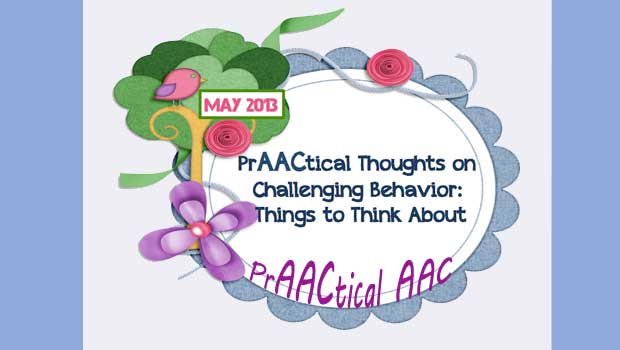
We have had several experiences in the last couple of weeks relating to concerns from SLP’s and educators about challenging behavior (dare we say it might be less structure, less predictability, less routines, or just plain tiredness because it is the end of the school year). Challenging behavior is hard… and disconcerting especially if you feel that you have little control over it (imagine how the learner feels- almost no one wants to be unhappy and out of control). However, there are so many strategies and supports that can improve the situation. It is often about getting back to basics (especially if end of the year issues play into the challenging behavior). The First 5 Questions to Ask: How Does the Learner Communicate? It is important that everyone has a way to communicate their own wants, needs, ideas, interests, and more. It is NOT good enough to just ‘know’ what someone... [Read More...]
May 16, 2013
by Robin Parker -
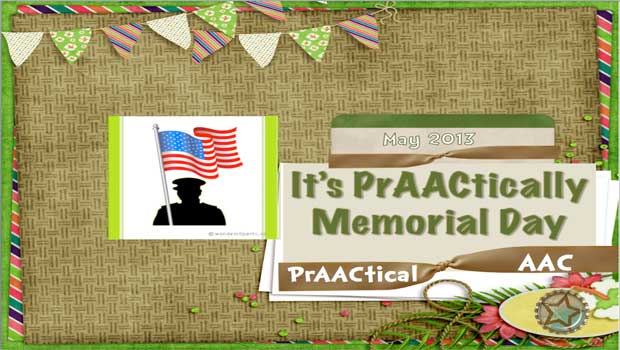
It’s PrAACtically Memorial Day! Memorial Day is prAACtically here. We remember, appreciate, and honor the people who have protected our freedoms. Getting ready so EVERYONE can participate is important. We wrote about memorial day last year and had found some good gluten-casein free Memorial Day recipes. There are even more resources today. Check out Gluten Free Memorial Day Weekend Menu and Recipe Ideas or Gluten Free Casein Free Applesauce Muffins. Cooking and baking provide meaningful language experiences as well as just plain fun. There are symbol based recipes on Pinterest at Picture Recipes and Visual Recipes for Children with Autism, and at Specialty Chef. There are also prAACtical AAC ways to teach about Memorial Day’s meaning as well as the typical memorial day vacations, activities, and events. Learning about Memorial Day Memorial Day Activity Board Memorial Day Vocabulary Cards Memorial Day Bingo Memorial Day Adapted Bingo Summer Pack Memorial Day After learning about Memorial... [Read More...]
April 25, 2013
by Carole Zangari -
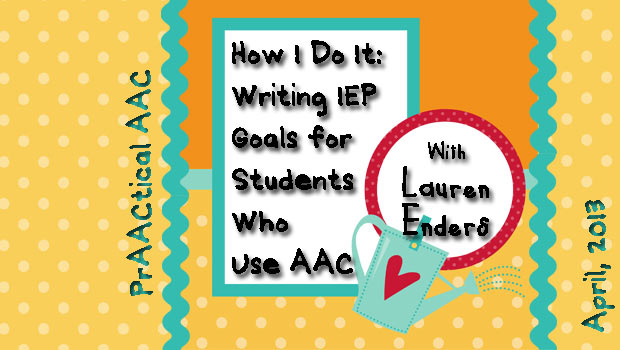
We’re so happy to welcome Lauren Enders back to share some more thoughts on AAC and the IEP. In her first post on this topic, Lauren addressed some frequently asked questions. Today, she provides a very valuable perspective on writing IEP goals for students who use or need AAC and some wonderful resources. Very often, I receive requests for support from teachers and speech therapists that are writing IEP goals for their students who use AAC. When we sit down to discuss their questions, the first thing I remind them is that AAC goals are no different from any other IEP goal. I recall a workshop I attended years ago presented by Gail VanTatenhove that helps put IEP goals for AAC into perspective. Gail said that AAC therapy is just language therapy. Isn’t that true? Aren’t we just teaching language? For this student, language is simply being expressed in a... [Read More...]
February 13, 2013
by Carole Zangari -
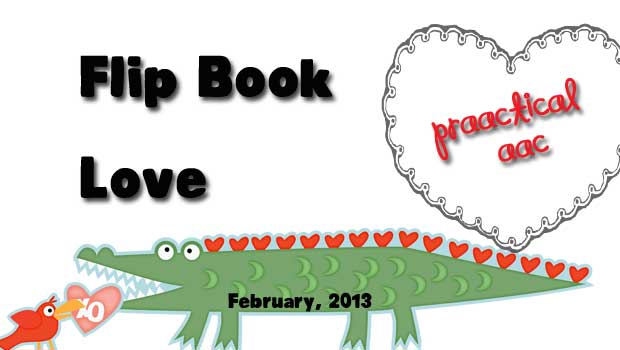
We love the versatility of flip books and charts. They are a great format option for communication books, particularly the flip books that have a static ‘base’ and a set of strips/mini pages that you can flip through for additional vocabulary. Once you have a template, it’s not too difficult to make a number of them that fit different purposes. Here are some resources to explore. SET-BC has wonderful material on communication supports including a brief video about flip books here. They also have some terrific downloads, including this one by Kathy Ryan. Flip ‘n Talk has been around for a long time, but it continues to be a really useful tool. We typically have the core language as the static portion, but here’s an example of doing it the other way around. There are so many ways to use flip books for language learning. We love this one for... [Read More...]
January 29, 2013
by Robin Parker -
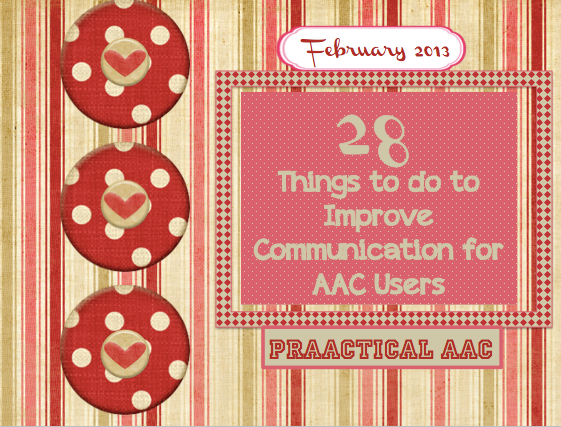
It’s almost February and and we were thinking about ways to encourage communication in a fun and meaningful way for the whole month. The best way we know is to build a visual language environment by providing lots of AAC modeling (Aided Language Input-ALI) and by using lots of visual supports. Here are some ideas to expand opportunities and/or to get started. We would love to know what works, what doesn’t, and any other ways you build visual language into everyday experiences. Use Aided Language Input (ALI) to say ‘I Love You’ . Make it part of a routine Offer learners a book choice board/choice book when deciding what book to read in speech-language therapy/classroom/home Use Aided Language Input (ALI) to tell how you feel when something is hard or difficult for you Use a ‘stop sign’ symbol to indicate an off limit area Use Aided Language Input (ALI) to... [Read More...]
January 28, 2013
by Robin Parker -
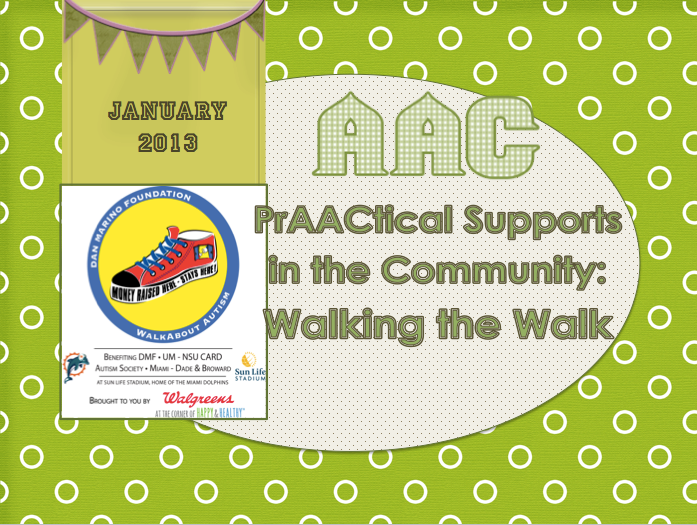
We are extremely proud to be part of the Dan Marino Foundation WalkAbout Autism, which is a large South Florida event. It is a true collaboration between the community, volunteers, sponsors, donors, walk partners, and the Miami Dolphins. The Walkabout helps raise money for organizations that provide programs and services for individuals with autism and other developmental disabilities. It also promotes a sense of community collaboration and awareness about autism spectrum disorder and developmental disabilities. We are writing about the WalkAbout, not as a plea for money (although read about the WalkAbout and donate if you are so inclined), but instead to tell you how we continue to try to integrate AAC & visual strategies into community events. We are so grateful to Dan & Claire Marino and their family and Jeff & Rachel Ireland and their family for continuing to dedicate their time and effort for this amazing event. This past weekend was the 3rd WalkAbout Autism. It was a... [Read More...]
January 26, 2013
by Carole Zangari -
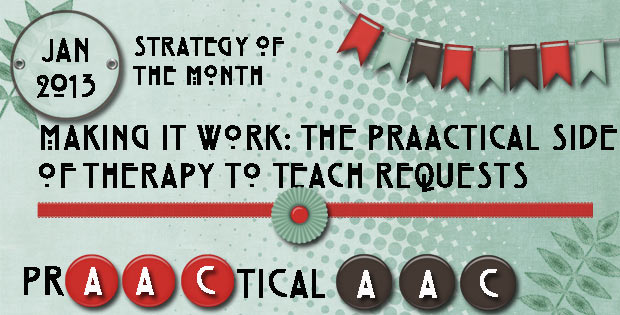
This month we’ve been talking about requesting and choicemaking, specifically how to teach it. Today, we’ll put it into a clinical context by talking about a hypothetical session that targets this skill, but also highlights other strategies. As you read about the materials, preparation, and script, look for how they incorporate strategies such as building specific communication opportunities {CO}, aided language input {ALI}, and expansions {EX}. The clinician also builds in repetition with variety so that there is sufficient opportunities for teaching and practice using multiple modes of communication. In this scenario, you’ll meet Jenna, a 5 year old with significant language difficulties secondary to Cri du Chat syndrome. Jenna’s communication system includes about a dozen manual signs (SIGN), 20-25 word approximations (SPEECH), a few gestures (GEST), some manual communication boards (COMM BD), and an iPad with a full-featured AAC app (iPAD). She also uses movement (MOVEMT), vocalizations (VOC), and... [Read More...]
January 19, 2013
by Robin Parker -
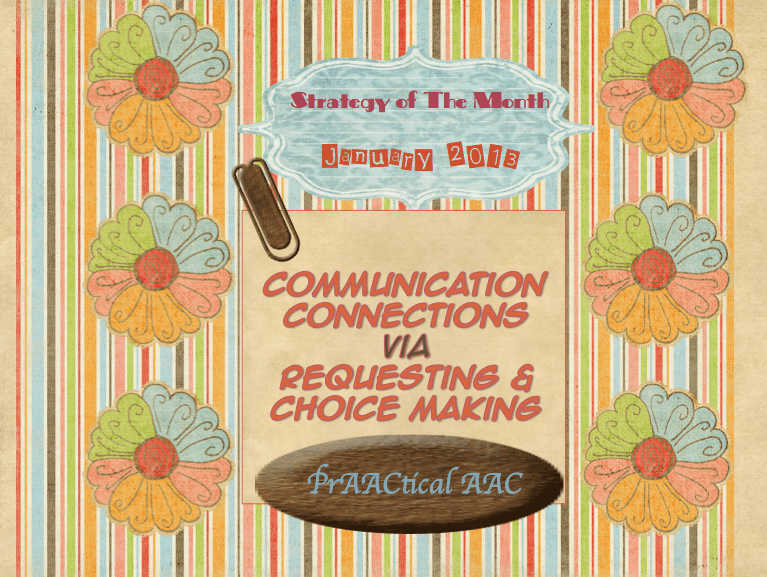
The January Strategy of the Month has focused on requesting and choice making. These are really fun goals to implement. They fall under the communication function that helps us meet our own needs (Behavioral Regulation). When we get what we want, there is a sense of control over the environment & we increase symbolic communication/language, and self-sufficiency. It’s all good. The assumption for all requests and choices is that the learner ‘likes’ what they have asked for. This is what makes the process so much fun, we get to do activities and have interactions that are positive and motivating. If only it was that easy… Sometimes it is not… But do not worry…there are plenty of solutions for common (and not so common) problems when teaching requesting and choice making. As always, set the stage for a positive TEACHING paradigm and then move to problem solving if necessary (and when it is... [Read More...]
January 4, 2013
by Carole Zangari -
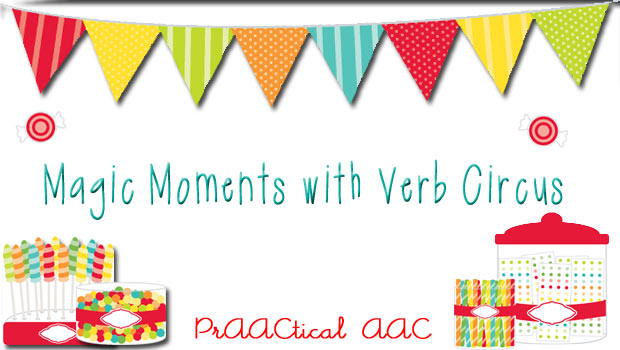
We are so excited to see the expanded web presence by SLPs who are blogging, running groups on Facebook, sharing resources on Pinterest, and maintaining online stores on TeachersPayTeachers. We’ve been thinking about how to connect with some of these creative professionals, both to extend our own professional learning networks and also to broaden the reach of our AAC message. Recently, when an opportunity to forge a few connections presented itself, we decided to collaborate with a few new SLP friends. Periodically, we will be featuring the materials of a fellow SLP who typically writes for colleagues serving primarily children with high incidence disabilities. They post great ideas and materials for students with articulation and phonological difficulties, fluency problems, and language disorders. We hope to put a prAACtical spin on their great ideas. In our inaugural post of this type, we hope to inspire some Magic Moments with fellow SLP Jocelyn... [Read More...]
December 6, 2012
by Robin Parker -
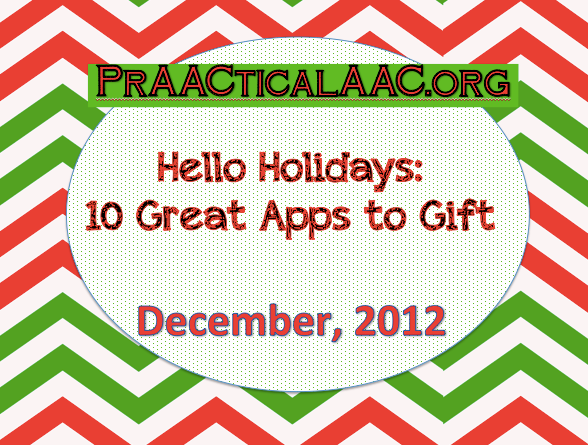
The holidays are prAACtically here and depending upon the holiday traditions you celebrate they may be closer than you realize. Time seems to fly after Thanksgiving and before you know it, social norms seem to dictate gift exchanges, lots of invitations to people’s houses, and of course many gifts for friends and family. An easy way to accomplish gift giving is to ‘gift an app’. You can give apps that are pure fun, educational or a combination of both. To top it off, it is easy to stay within budget, avoid traffic, avoid crowds, and save tons of time (no need to wait for it to arrive). Before you think it’s too complicated, check out these ‘Gifting an App’ instructions by Cult of Mac. The process could not be simpler and you can email the recipient(s) or print out a gift certificate (if necessary right before the gift is needed).... [Read More...]









